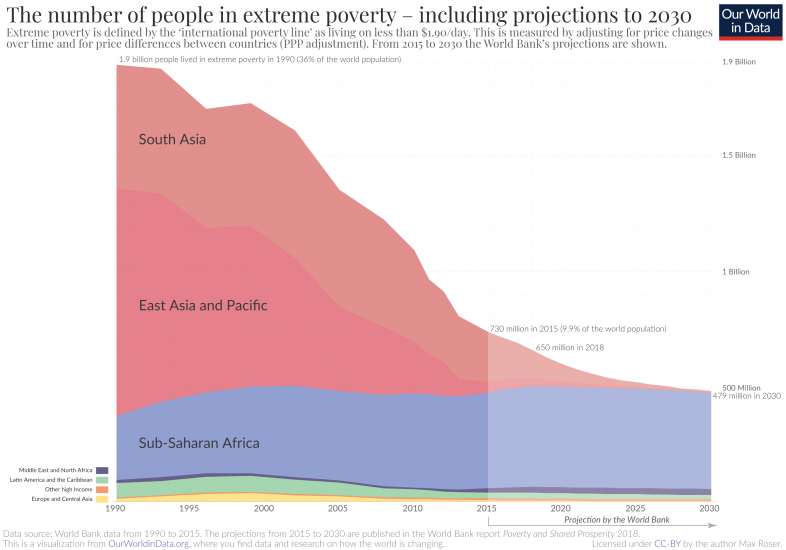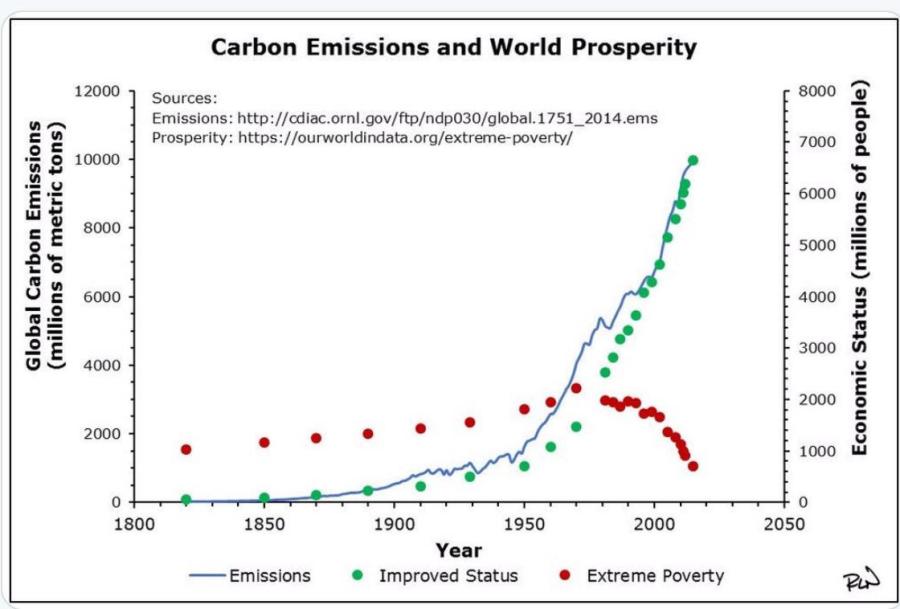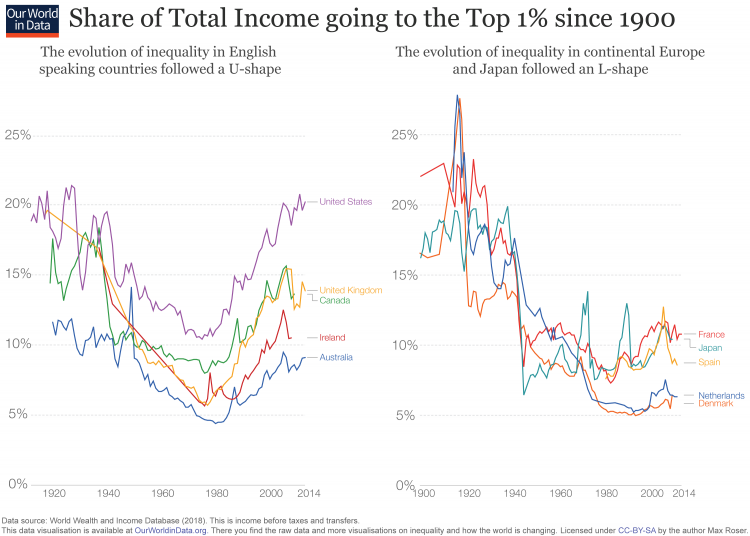
Here’s an encouraging thought: extreme poverty has been largely alleviated. In 1820, 94% of the world’s population lived in extreme poverty (the equivalent purchasing power of under US $1.9/day). In 1990, the figure had dropped to 34.8%, which is already a big improvement. But since 1990, in just 30 years, the figure has dropped to 9.6%. The world’s poorest are taking strides towards escaping extreme poverty.
Not only is the proportion of people living in extreme poverty at a record low — but despite adding 2 billion people to the planet’s population in the past few decades, the overall number of people living in extreme poverty has still fallen. In the last 25 years alone, 1.25 billion people escaped extreme poverty — a whopping 138,000 people every day. This is an enormous achievement that
But we shouldn’t pat ourselves on the back just yet. In between extreme income inequality, climate change and pollution, and decreased social freedom, there has been a great price to pay for this progress — and many economists believe we could have done even more.

Poor, but not extremely poor
It’s always hard to define poverty. The extreme poverty threshold was updated in 2015 to the equivalent of $1.9 — which, most people would agree, is an extremely low figure.
Extreme poverty is meant to be, well, extreme. Conceptually, it is meant to be the limit at which you have problems satisfying even the most basic of human needs.
But that doesn’t mean that once you’re out of it, all is fine and dandy. People living at $2 and $5 per day also face severe hardships.
We should also be paying attention to what happens to other low-income brackets, and things are less encouraging there.
The majority of the world is still living at under $10 per day — 2 out of 3 people worldwide are under this threshold. The proportion of “rich” people, who can afford to spend more than $10 per day has increased from approximately 25% to 35% in the past 40 years.
That’s positive, but less encouraging –especially since $10 per day is not exactly a very high standard. Overall, however, the world is taking important steps towards reducing and eliminating poverty.
The poverty gap, another common measure of global poverty, has also steadily decreased in recent years.
However, one macroeconomic area is still greatly lagging behind.
Poverty has changed dramatically everywhere in the world — except Africa
In 2013, there were 746 million people living in extreme poverty. Out of these, 380 million resided in Africa, and 327 million resided in Asia. That means that around 95% of people in extreme poverty live in Asia and Africa. However, Asia and Africa aren’t exactly similar in this regard.
The world’s most populous country, China, has only 25 million people living in extreme poverty — an impressive improvement from just 20-30 years ago. In fact, 218/327 of Asia’s poorest people live in India.
Meanwhile, aside from North Africa, the entire continent seems to struggle with extreme poverty.
Indeed, much of the progress with global poverty has come from East Asia and the Pacific area, where poverty rates went from 81% four decades ago to 2.3% in 2015.
Meanwhile, in sub-Saharan Africa, the number of people (note: the total number of people, not the percentage) has increased since 1990. In sub-Saharan Africa, there is also a correlation between the incidence of poverty and the intensity of poverty — in other words, it’s not just that the people are more likely to live in extreme poverty, but this is also the region where people tend to fall furthest below the line.
Poverty was not concentrated in Africa until very recently. Even in 1990, more than a billion people in extreme poverty lived in India and China. However, the rapid progress in these areas has left Africa behind.
Population growth is also most accelerated in African areas. According to the World Bank, 87% of the world’s poorest are expected to live in sub-Saharan Africa by 2030.

This being said, the percentage of people in Sub-Saharan Africa is also decreasing — it’s just decreasing

The sacrifice?
No doubt, alleviating global poverty is one of the loftiest achievements mankind can pursue. There’s no denying that. However, whether the end justifies all means is a completely different question.
The strongest example of this is China. China embraced the free market, but it also embraced authoritarianism; they prioritized economic development at the cost of social freedom. China ranks 153/167 in the Global Democracy Rank, being as democratic as countries such as Eritrea, Burundi, and Iran. A quarter of a century later, China’s transformation is shocking, and human rights are little more than an afterthought for the Asian giant.
It’s not just democracy that was sacrificed in some cases — the environment also had to suffer. Much of this economic growth was powered by coal and other fossil fuels, rising atmospheric greenhouse gas emissions to unprecedented levels. Per capita, developed countries still heavily outweigh developing areas, but China has become the world’s largest emitter. If economic growth is to become sustainable, it must decouple from greenhouse gas emissions. Currently, carbon emissions and prosperity seem to be linked, but we are are seeing some progress in the area.

The rich get (much) richer
Income inequality is also a burning topic. After all, the entire world is getting richer, so the proverbial pie is getting bigger — are impoverished areas getting substantial portions of that, or is it just scraps?
Income inequality is a complex process to analyze, and it’s not uniform. An income over $14,500 in 2013 was sufficient to put you in the global top 10% richest — and yet, in the world’s richest countries, that would be considered a very low figure.
However, income inequality estimates are not fully comparable across countries in different world regions. Even with these differences
Global income inequality is currently high, but as mentioned, there are both similarities and major differences across different countries. In the first part of the 20th century, inequality decreased in most of the developed world. But in the second part of the century, global inequality started to increase, and this is especially prevalent in English speaking countries, whereas in countries like France, Germany, or Japan, inequality has remained more stable.

The long-term increase in income inequality raises social and political concerns, as well as economic ones, tending to make it more difficult for people to escape poverty and bridge the economic gap.
What’s next?
There has been remarkable progress in the past few decades, but there is absolutely no reason to get complacent about poverty.
No matter how you look at it, the share of people living in extreme poverty has decreased — and if things go as planned (which is likely, but not guaranteed), the share will continue to decrease throughout the next decades.
However, if people are simply moving from ‘extreme poverty’ to ‘poverty’, that’s not sufficient. The world has gathered tremendous wealth in the past few decades, and the free market has created a tremendous opportunity to escape poverty — but if this opportunity is not backed by responsible social policy, we will continue to see income inequality rise while the poorest struggle.
Furthermore, tackling poverty in a way that’s sustainable, equitable, and democratic remains as challenging as ever. We have our work cut out for us the future.


